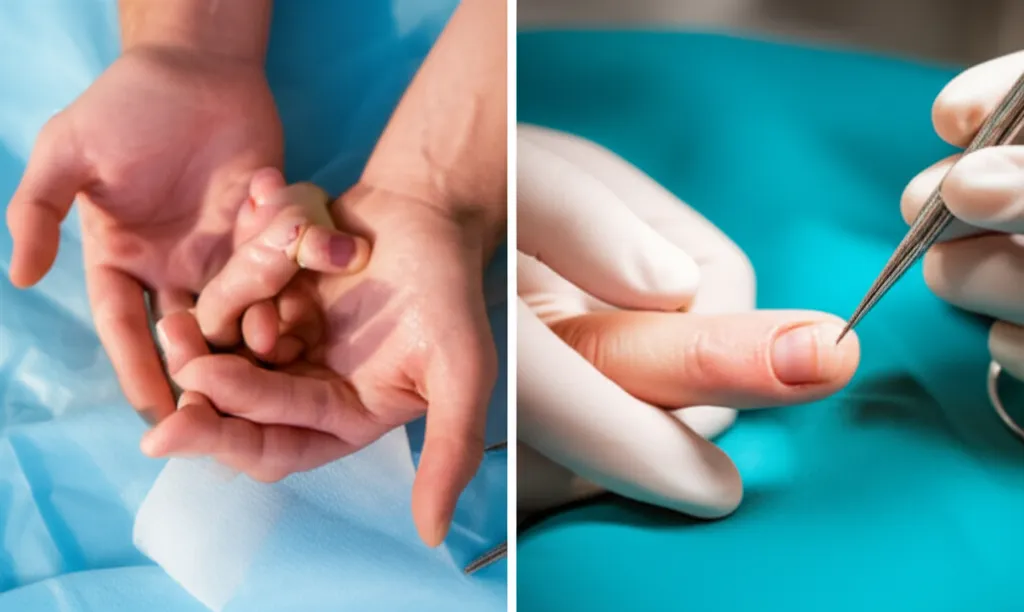Picture this: you’re just chasing the evening ritual—dicing veggies for pasta—when your knife slips. There’s pain, blood, panic. Now what? I’ll admit, I nearly fainted the first (and hopefully last) time my uncle did something similar, but it got me thinking: how do people actually handle a severed finger emergency? Here’s the wild, behind-the-scenes truth, with advice you’ll wish you memorized—before the accident.
Instant Response: Don’t Google—Act Fast!
In the split second after a fingertip injury, your instincts matter more than your search history. When you’re staring at a bleeding hand, don’t waste precious time scrolling for answers—your first aid response can make all the difference between saving a severed finger and losing it forever. Here’s what you need to know, right now, to control a bleeding wound, manage pain, and give yourself the best shot at recovery.
First Aid for a Severed Finger: Control the Bleeding, Stay Calm
The first priority is simple but urgent: control the bleeding wound. Your heart may be racing, but your actions need to be steady. Grab anything clean—paper towel, dishcloth, even your shirt if that’s all you have—and press it firmly against the wound. Don’t be afraid to use direct pressure; this is your best tool to slow the blood loss. But remember, you’re not trying to cut off circulation. Don’t overdo a tourniquet—in most fingertip injuries, it’s not necessary and can do more harm than good.
- Apply direct pressure with a clean cloth or towel.
- Elevate your hand above heart level to slow the bleeding.
- Check the bandage—it should be snug, but not so tight that your finger turns pale or cold.
Every second counts. The initial moments after a severed finger are crucial for long-term outcomes. Don’t let panic or indecision steal your chance at recovery.
Pain Management for Finger Injury: Choose Wisely
When it comes to pain management for finger injury, not all medications are created equal. It’s tempting to reach for whatever’s in your medicine cabinet, but some painkillers can actually make things worse. Ibuprofen—a common go-to—can hinder blood clotting, increasing your risk of further bleeding. Instead, reach for acetaminophen (Tylenol), which helps with pain without interfering with your body’s ability to stop the bleeding.
"To manage the pain, she knows not to take ibuprofen, which would prevent the wound from clotting and instead opt for acetaminophen."
- Avoid ibuprofen and other NSAIDs immediately after injury.
- Acetaminophen is safer for pain control in these cases.
Remember, pain relief isn’t as simple as popping any pill—choose wisely to protect your chances of recovery.
Emergency Response for Fingertip Injury: Save the Severed Part
If you’re unlucky enough to see your finger on the floor, don’t panic. Your next move is critical. First, gently rinse the severed finger with clean water or sterile saline. Don’t scrub or use harsh chemicals—this isn’t the time for a deep clean. Wrap the finger in a clean, moist towel or gauze. Then, place it in a sealed plastic bag, and put that bag on top of ice in a cooler. Never let the finger touch ice directly, as this can cause further tissue damage.
- Rinse the severed finger gently—no scrubbing.
- Wrap in a clean, moist cloth or gauze.
- Seal in a plastic bag, then place on ice (not in ice).
These steps help preserve the tissue for possible reattachment. The window for successful surgery is tight—usually six to twelve hours—so every minute matters.
Call for Help: Speed Over DIY
Once you’ve controlled the bleeding and secured the severed finger, call emergency services immediately. Don’t try to drive yourself if you’re bleeding heavily or feeling faint. The faster you get to a hospital—ideally one with a hand surgeon on staff—the better your odds. Remember, bravado and DIY fixes can cost you precious time and function. In these moments, speed matters more than anything else.
- Call 911 or your local emergency number right away.
- Bring the severed finger with you, properly packed.
- Keep your hand elevated and pressure on the wound during transport.
In the chaos of a traumatic injury, your instant response—not your search engine—is what gives you the best chance at saving your finger and your future independence.

Save the Finger, Save the Day? The Do’s and Key Don’ts
When it comes to a severed finger, every second counts. The difference between a successful surgical reattachment and a permanent loss often comes down to what you do in the first few minutes. If you ever find yourself in this situation, knowing the right steps for first aid for a severed finger could literally save the day—and the finger. Let’s break down the essential do’s and don’ts for proper preservation of a severed finger and the realities of limb reattachment surgery challenges.
Do: Preserve the Severed Finger the Right Way
- Keep it clean, but gentle: If the finger is dirty, gently rinse it with clean water. Avoid scrubbing or using harsh chemicals—overzealous cleaning can destroy delicate tissues that surgeons need for reattachment.
- Wrap in moist gauze: Moisten a clean towel or sterile gauze with saline or clean water. Wrap the severed finger in this moist material. This keeps tissues hydrated and slows down cell death.
- Bag it up: Place the wrapped finger in a clean, waterproof plastic bag. Seal the bag to protect it from contamination.
- Cool, but not frozen: Put the sealed bag on top of ice or in a cooler. Never place the finger directly on ice or let it freeze—this can cause more tissue damage and make reattachment impossible.
"Surprisingly, severed tissues can survive for a few hours without these resources and keeping them cool further slows the rate of tissue death."
Don’t: Make These Common Mistakes
- Don’t put the finger directly on ice: Direct contact with ice can freeze and kill the tissue. Always use a barrier like a plastic bag and moist gauze.
- Don’t scrub or disinfect aggressively: Scrubbing can destroy vital structures like nerves and blood vessels. Gentle rinsing is enough.
- Don’t delay: The clock is ticking. You have about 6-12 hours before tissue death makes reattachment impossible. Get to a hospital with hand surgery expertise as fast as possible.
- Don’t assume every finger can be saved: Messy, jagged injuries from car or machinery accidents, or fingers lost due to disease, are rarely candidates for reattachment. Clean, sharp cuts have the best chance.
The Race Against Time: Why Speed Matters
Once a finger is severed, its blood supply is instantly cut off. Oxygen and nutrients stop flowing, and tissue begins to die. Cooling the finger slows this process, buying precious time for surgeons to attempt reattachment. But even with perfect preservation, there’s a hard limit—6 to 12 hours is the typical window for successful surgical reattachment of a finger.
Think of it this way: express delivery seems slow compared to the urgency here. Every minute counts, so act fast and get to the nearest hospital equipped for limb reattachment surgery.
Not Every Finger Can Be Saved
It’s important to know that even if you do everything right, not every finger can be reattached. The type of injury matters—a clean, sharp cut is ideal, but most accidental amputations are far messier. Car crashes, industrial accidents, and machinery often leave behind crushed, torn, or contaminated tissue. These injuries are much harder, if not impossible, to repair.
In fact, more than half of limb amputations in the United States are due to disease, not accidents. Fingers or limbs removed for medical reasons are not safe for reattachment.
Quick Reference: First Aid for a Severed Finger
- Gently rinse the finger with clean water if dirty.
- Wrap in moist, sterile gauze or a clean towel.
- Place the wrapped finger in a sealed plastic bag.
- Rest the bag on ice or in a cooler—never direct contact with ice.
- Seek immediate medical attention at a hospital with hand surgery expertise.
Key Takeaways
- Proper preservation of a severed finger is critical for reattachment success.
- Moist gauze and indirect cooling buy time—never freeze or use direct ice.
- Clean, sharp cuts have the best chance; messy or disease-related amputations usually can’t be reattached.
- Act fast—6 to 12 hours is your window for possible limb reattachment surgery.

Beyond the Miracle: Reattachment, Prosthetic Tech, and That Thing Called Resilience
When you hear about someone losing a finger, it’s easy to imagine that surgical reattachment is a miracle fix—a quick trip to the hospital, a skilled surgeon, and everything goes back to normal. But the reality is far more complicated. Surgical reattachment of a finger is a race against time and biology. Most hospitals simply don’t have the specialized tools or expertise needed for these delicate, time-sensitive procedures. Even if you’re lucky enough to be in the right place at the right time, the surgery itself is just the beginning.
Inside your hand are tiny bones, blood vessels, and nerves, each one needing precise repair. With a perfectly clean cut, surgeons might be able to stitch nerves back together. But more often, the cut is ragged, and doctors must create a “nerve conduit”—a sort of tunnel that encourages nerves to reconnect over time. Even with the best surgical skills and technology, restoring full movement and sensation is rare. The surgery can take up to eight hours, and recovery is measured in months, not days. Occupational therapy for hand recovery becomes your new routine, and even then, your hand may never feel quite the same. This is the unseen reality of surgical reattachment: it’s not a miracle cure, but a challenging journey that demands patience, hope, and a lot of resilience.
When reattachment isn’t possible—or when the risks outweigh the potential benefits—modern medicine offers another path: prosthetic limb advancements. Today’s prosthetics are marvels of engineering. While prosthetic legs have long helped people walk and run, prosthetic arms have struggled to match the hand’s fine motor skills. That’s changing fast. Myoelectric prosthetics technology can now detect electrical signals from your muscles and translate them into surprisingly precise movements. Imagine flexing your forearm and watching your prosthetic fingers open and close, almost as if they were your own. It’s not science fiction—it’s happening in clinics around the world.
Perhaps the most dramatic leap forward is trans osseous integration. First performed in 1990, this surgical technique anchors a metal implant directly into the bone of your remaining limb. Over time, your bone grows into the implant, creating a strong, permanent connection. The prosthesis attaches right to this anchor, making it feel lighter and more natural than traditional socket-based limbs. For many, this means fewer skin problems, better mobility, and a renewed sense of confidence. These advances are transforming what life after amputation can look like, offering hope where there once was only loss.
But here’s something you might not expect: not everyone chooses surgery or a prosthesis. As one patient put it,
"Even with all these new technologies, not everyone wants to replace or reattach a lost limb. After an amputation, some people opt to rely on their remaining limbs with or without the help of mobility aids and other adaptive equipment."
Some people find their own path, adapting to daily life with one less finger or hand. They learn new ways to tie their shoes, type, or cook. They might use simple tools or develop unique habits. This is resilience medical recovery in its purest form—not always high-tech, but always deeply human. Recovery, after all, is as much about the mind as the body. Support from family, friends, and therapists is just as vital as any surgical technique or device.
Every journey after amputation is unique. Some find hope in the latest prosthetic limb advancements, embracing myoelectric prosthetics technology or bone-anchored devices. Others rely on occupational therapy hand recovery, working tirelessly to regain function and independence. And some simply adapt, proving that resilience can take many forms—sometimes powered by technology, sometimes by sheer determination.
In the end, losing a finger is never just about what’s lost. It’s about what you discover in yourself—the ability to adapt, to heal, and to move forward, no matter which path you choose. Whether through surgical reattachment, prosthetic innovation, or everyday adaptation, the real miracle is resilience. And that’s something no accident can ever take away.
TL;DR: Don’t panic if you ever lose a finger—quick thinking, proper care, and medical innovation can work wonders. Just remember: stop the bleeding, save your finger (correctly), and never underestimate advances in prosthetics, even if a reunion with your lost digit isn’t in the cards.



